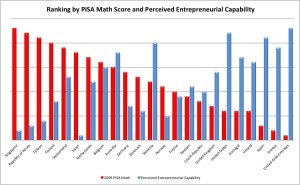 For the past 10 weeks, we’ve been working with schools and teachers in three countries: China; India and Australia. During that period, the 2012 PISA results were announced, triggering a renewed bout of angst in Western countries generally, giving way to more strident calls to work our students harder, along with some intensive teacher bashing.
For the past 10 weeks, we’ve been working with schools and teachers in three countries: China; India and Australia. During that period, the 2012 PISA results were announced, triggering a renewed bout of angst in Western countries generally, giving way to more strident calls to work our students harder, along with some intensive teacher bashing.
In this post, I’d like to share some impressions I formed in those countries, aligned with political and mainstream media representations, post-PISA. It can only be a small, selective sample, but I’ll share other learnings in subsequent posts.
Indian Inspirations
Our week in one of the planet’s mega-cities, New Delhi, provided a stark reminder that, whatever concerns most of us have about school funding, and the status of teachers, it’s all relative. India is a country where, I was reliably informed, teacher absenteeism rates can be as high as 70%. The underlying cause seems to be a mixture of low pay (public school teachers invariably need to have a second job) and the low esteem surrounding teaching as a profession.
 Despite this, I met highly innovative school leaders, working under testing circumstances, but achieving high student engagement and exemplary exam results. Springdales School in Delhi, is a good example of an OPEN school: its commitment to service and community is one of the factors, according to its visionary principal, Ameeta Wattal, behind its high level of student engagement. Their ‘Each One Teach One’ and ‘Adopt A Gran’ schemes are just two examples, among many, of students supporting communities in tackling poor literacy rates and social isolation in an increasingly fragmented society. Hearing students talking about how their own learning had progressed through teaching others was humbling.
Despite this, I met highly innovative school leaders, working under testing circumstances, but achieving high student engagement and exemplary exam results. Springdales School in Delhi, is a good example of an OPEN school: its commitment to service and community is one of the factors, according to its visionary principal, Ameeta Wattal, behind its high level of student engagement. Their ‘Each One Teach One’ and ‘Adopt A Gran’ schemes are just two examples, among many, of students supporting communities in tackling poor literacy rates and social isolation in an increasingly fragmented society. Hearing students talking about how their own learning had progressed through teaching others was humbling.
The Indian government faces a colossal task in improving schooling. After finishing 72nd out of 73 PISA countries in 2009, it dropped out of the 2012 assessment, claiming its students weren’t ready. Spending on education in India has quadrupled since 1980, but, in the fastest growing student population in the world, they still have a formidable task on their hands..
The focus of our week there was to work with the development team of Vega schools – the brainchild of Sandeep Hooda, a self-made entrepreneur who wants to not only build schools fit for the 21st century, but also transform the status of education in India. After working with his team, I believe he might just do it. The first Vega school opens in 2015, and helping students to be independent, engaged, lifelong learners is just what the system there needs – though it will be some time before the impact will be seen.
The Cream of the Crop?
There has been considerable speculation about the spectacular rise up the PISA tables of China’s schools. The week I spent in another mega city, Shanghai, wasn’t at all representative – I was working with the British International Schools in China. These are well-funded, independent, schools with students recruited from international middle-class families, and kids from aspiring Chinese parents (strange that, despite Shanghai topping the PISA tables, local families who can afford to pay for their kids education seem to favour the lower-performing British model).
 I did some guest teaching in two International schools in Shanghai. There was a noticeable difference in the way students engaged: American, British and other European kids seemed happy to work with minimal direct instruction, and produced some highly creative results. The local students, on the other hand, whilst being highly attentive, were clearly struggling to work independently. Stereotypes aren’t always groundless, and the Chinese government has recognised that they urgently need to change curriculum and pedagogy. Topping PISA is of dubious merit if China’s incredible economic boom is to be sustained through the development of creativity and enterprise in its current students.
I did some guest teaching in two International schools in Shanghai. There was a noticeable difference in the way students engaged: American, British and other European kids seemed happy to work with minimal direct instruction, and produced some highly creative results. The local students, on the other hand, whilst being highly attentive, were clearly struggling to work independently. Stereotypes aren’t always groundless, and the Chinese government has recognised that they urgently need to change curriculum and pedagogy. Topping PISA is of dubious merit if China’s incredible economic boom is to be sustained through the development of creativity and enterprise in its current students.
The Chinese media has also been highly circumspect in post-PISA analysis: like Yong Zhao, they know that a system that has traditionally trained students to do well in exams, is likely to excel in international yardsticks measuring students ability to pass exams! (Not to mention the gross inefficiency of Asian education systems, that I previously blogged about)
Meanwhile, The ‘Lucky Country’ Frets….
The remainder of my trip was spent in Australia, a country that I’m coming to know well. Inherently optimistic, Aussies had their ‘she’ll be right’ attitude undermined by excessively negative media reaction to its PISA performance.
I’ll save the impressions from the Australian schools I visited for a later post, but the media knee-jerkers were out in force after PISA published its latest results, and some perspective is much needed.
In 2013, the then Prime Minister, Julia Gillard (foolishly) set a goal of being in the top 5 nations when it comes to PISA. There must have been 20 or more countries set themselves the same top-five PISA target, but that’s another story….
Australia ‘slipping’ down PISA – from top five(ish) in 2000, to mid-teens in 2013 – is less to do with a drop in standards, than the widening of the PISA club. The arrival of Singapore, Korea, Chinese Tapei, Shanghai, Hong Kong and Macau has nudged everyone down at least 5 places. (China is highly selective in who is entered for PISA, which is why its territories occupy 4 of the top 6 places, rather than a single nation.)
Does this mean that countries like Australia should be complacent? Absolutely not. But the Aussie performance is all about social inequality: if indigenous and remote kids in Australian schools performed as well as their counterparts in urban, independent schools, there’d only be one winner in PISA, and we’d all be visiting Sydney and Melbourne.
How Should We Judge The Health Of A Nation’s Education System?
At the start of my trip, a longitudinal research report emerged, suggesting that if we focussed more upon student engagement, rather than achievement, we would have a more reliable indicator of long-term life chances. It also, remarkably, implied that the so-called ‘inequality gap’ between rich and poor students, could be bridged by a serious sustained commitment to student engagement.
And let’s not forget Yong Zhao’s striking comparison of PISA performance against entrepreneurial capabilities (see below)
So, how do we interpret success: is it by our students short-term capacity to perform in tests, or in their long term realisation of learning potential?
Having recently worked with students and teachers at three points of the PISA success story, I can’t help but think that any international assessment of student achievement should assess students’ life chances over 20 years. Only then can we really see whether a lifelong engagement in learning, developing creative and entrepreneurial skills, is more significant than passing literacy and numeracy tests at 15 years of age.
If we did that, might it explain how the country with some of the most consistently mediocre international comparison results over 30 years – the USA – has been the most innovative and dynamic of economies during the same period?








Presentation of the bar graph is pretty bad maths. No vertical scale and origin chosen to accentuate differences that could be quite marginal. Perceived entrepreneurial performance presented in the description on the same base as measured maths performance? It could well be that chasing marginal improvements in maths that few people actually use is not that important either way. The link between these marginal differences and overall economic performance is a political issue not something that can be objectively determined so producing misleading graphs and charts ends up with the old damn lies and statistics label.
Ian,
You’d have to take up the methodology issues with Yong Zhao himself. His worked is pretty well referenced and researched, so I’m sure he could explain. I used it because, even if only broadly representative, it present an interesting contrast, I think.